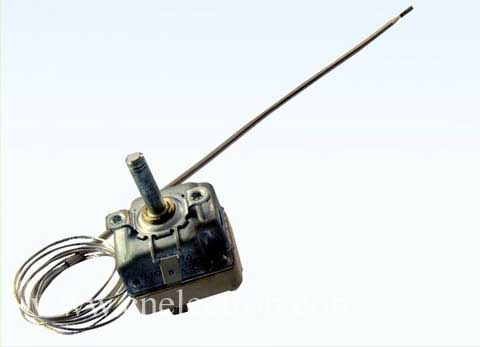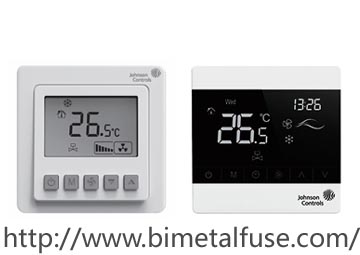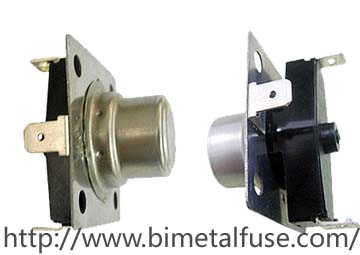Working principle of temperature control switch
Vapor pressure type temperature control switch works
The action of the bellows acts on the spring. The spring force of the spring is controlled by the knob on the control panel. The capillary is placed in the air inlet of the air conditioner to absorb the temperature of the indoor return air. When the room temperature rises to the set temperature, the temperature sensing agent gas in the capillary tube and the bellows expands, causing the bellows to elongate and close the switch contact against the spring force of the spring. At this time, the compressor is running, the system is cooled, and when the room temperature drops to the set temperature, the temperature-inducing gas shrinks, the bellows shrinks together with the spring, and the switch is placed in the off position to cut off the motor circuit of the compressor. This is repeated to achieve the purpose of controlling the temperature of the room.

Electronic temperature controller works
The electronic temperature controller (resistive type) is measured by the method of temperature sensing of the resistor. Generally, white gold wire, copper wire, tungsten wire, and semiconductor (thermistor, etc.) are used as temperature measuring resistors, and these resistors have their own advantages. Sensors for household air conditioners are mostly in thermistor type.
The thermistor thermostat is based on the Wheatstone bridge principle (left) is the Wheatstone bridge. Connect the power supply E to both ends of the BD. According to Kirchhoff's law, when the resistance of the bridge R1 × R4 = R2 × R3, the potentials of the two points A and C are equal. There is no current flowing between the output terminals A and C. The magnitude of the resistance R1 of the thermistor rises or falls with the ambient temperature.
The change is changed, the balance is destroyed, and there is an output current between the ACs. Therefore, when the thermostat is constructed, the temperature adjustment range and operating temperature can be easily changed by selecting an appropriate thermistor.

Metal expansion thermostat works:
According to the principle of thermal expansion and contraction of objects. Thermal expansion and contraction are commonalities of objects, but different objects have different degrees of thermal expansion and contraction. The two sides of the double gold piece are conductors of different materials. At different temperatures, the double gold piece is bent due to the different degree of expansion and contraction, and the set contact or switch is touched, so that the set circuit (protection) starts working.
Note: The KSD301 series is a snap-on plastic body that automatically resets.
The KSD302 series is a snap-on, ceramic-based body that automatically resets.
The KSD303 series is a snap-on type, with plastic as the main body and manual reset.
The KSD304 series is a snap-on, plastic-based, 16A dual contact, automatic reset.
The KSD305 series is snap-on, plastic-based, 16A dual contacts, automatic reset.

The action of the bellows acts on the spring. The spring force of the spring is controlled by the knob on the control panel. The capillary is placed in the air inlet of the air conditioner to absorb the temperature of the indoor return air. When the room temperature rises to the set temperature, the temperature sensing agent gas in the capillary tube and the bellows expands, causing the bellows to elongate and close the switch contact against the spring force of the spring. At this time, the compressor is running, the system is cooled, and when the room temperature drops to the set temperature, the temperature-inducing gas shrinks, the bellows shrinks together with the spring, and the switch is placed in the off position to cut off the motor circuit of the compressor. This is repeated to achieve the purpose of controlling the temperature of the room.

Electronic temperature controller works
The electronic temperature controller (resistive type) is measured by the method of temperature sensing of the resistor. Generally, white gold wire, copper wire, tungsten wire, and semiconductor (thermistor, etc.) are used as temperature measuring resistors, and these resistors have their own advantages. Sensors for household air conditioners are mostly in thermistor type.
The thermistor thermostat is based on the Wheatstone bridge principle (left) is the Wheatstone bridge. Connect the power supply E to both ends of the BD. According to Kirchhoff's law, when the resistance of the bridge R1 × R4 = R2 × R3, the potentials of the two points A and C are equal. There is no current flowing between the output terminals A and C. The magnitude of the resistance R1 of the thermistor rises or falls with the ambient temperature.
The change is changed, the balance is destroyed, and there is an output current between the ACs. Therefore, when the thermostat is constructed, the temperature adjustment range and operating temperature can be easily changed by selecting an appropriate thermistor.

Metal expansion thermostat works:
According to the principle of thermal expansion and contraction of objects. Thermal expansion and contraction are commonalities of objects, but different objects have different degrees of thermal expansion and contraction. The two sides of the double gold piece are conductors of different materials. At different temperatures, the double gold piece is bent due to the different degree of expansion and contraction, and the set contact or switch is touched, so that the set circuit (protection) starts working.
Note: The KSD301 series is a snap-on plastic body that automatically resets.
The KSD302 series is a snap-on, ceramic-based body that automatically resets.
The KSD303 series is a snap-on type, with plastic as the main body and manual reset.
The KSD304 series is a snap-on, plastic-based, 16A dual contact, automatic reset.
The KSD305 series is snap-on, plastic-based, 16A dual contacts, automatic reset.






